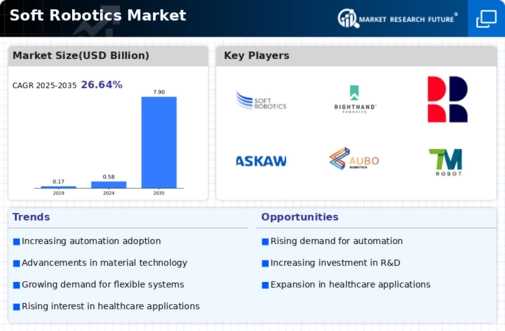Soft Robotics Size
Soft Robotics Market Growth Projections and Opportunities
When traditional inflexible robots operate near humans, safety problems frequently arise. Soft robotics solves these issues by offering a safer working environment for collaboration because of its compliant and pliable nature. This element is especially important in sectors where close human-robot interaction is becoming more widespread, such as healthcare and logistics. The acceptance of soft robotic solutions is fueled by the need for robots that can collaborate with people without endangering them. The importance placed on human-robot safety is another important market factor. Soft robotics are an appealing option for companies looking to boost productivity and cut expenses because of their versatility. The capacity of soft robots to maneuver in chaotic environments and carry out complex tasks adds to their integration in numerous sectors, boosting market expansion, from production procedures to logistics and beyond. These materials combine strength and pliability, making it possible to build robots that can stretch, bend, and take on different shapes. The ongoing investigation and assimilation of novel materials enhances soft robotic capabilities, impacting market dynamics and stimulating technical innovation. Technological developments in materials are a major factor influencing the soft robotics marketplace. Materials research advancements have produced pliable, supple materials that form the basis of soft robotic components. Intelligent algorithms and soft robotics work together to produce a synergistic impact that increases the market's likelihood for applications in smart robotics and autonomous systems. Additionally, the market is impacted by the continuous developments in machine learning (ML) and artificial intelligence (AI). Soft robotics' cost hurdles should drop as manufacturing techniques and efficiencies of scale advance, accelerating the technology's market adoption across industries. Support from regulations increases end users' trust and promotes the broad deployment of soft robots in situations where upholding safety and high standards of quality is crucial. The creation of a legal structure is essential to promoting a favorable atmosphere for market expansion and guaranteeing the responsible application of soft robotic technology. The next phase of automation and robotics will be shaped in large part by the soft robotics industry as market dynamics and technology continue to change. A wide range of interrelated issues, such as the need for automation, safety concerns, material innovations, AI integration, cost considerations, legal frameworks, and cooperative initiatives, have an impact on the soft robotics market.










Leave a Comment